Case Study Analysis | Pathophysiology
VerifiedAdded on 2022/08/13
|11
|3051
|18
AI Summary
Contribute Materials
Your contribution can guide someone’s learning journey. Share your
documents today.
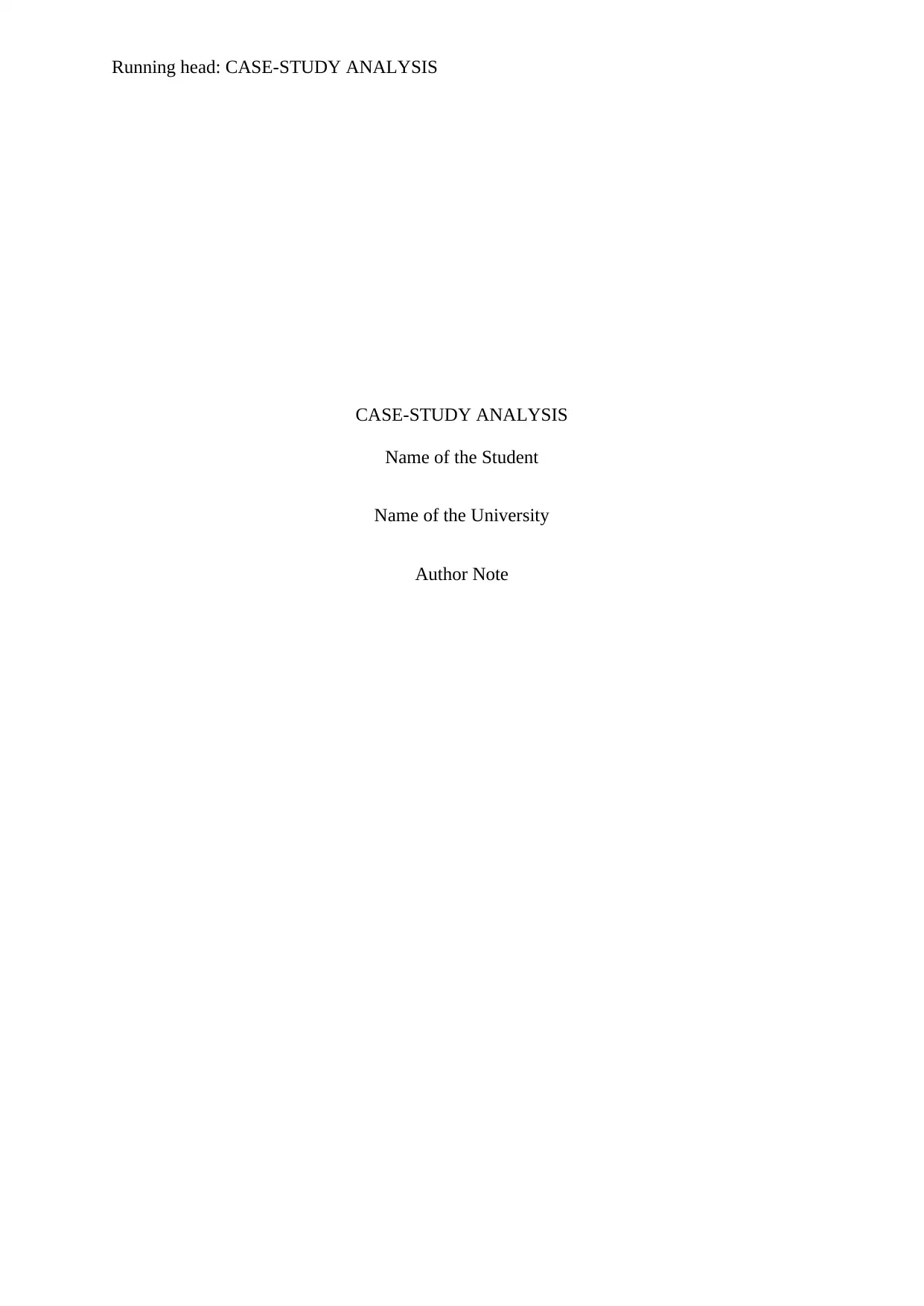
Running head: CASE-STUDY ANALYSIS
CASE-STUDY ANALYSIS
Name of the Student
Name of the University
Author Note
CASE-STUDY ANALYSIS
Name of the Student
Name of the University
Author Note
Secure Best Marks with AI Grader
Need help grading? Try our AI Grader for instant feedback on your assignments.
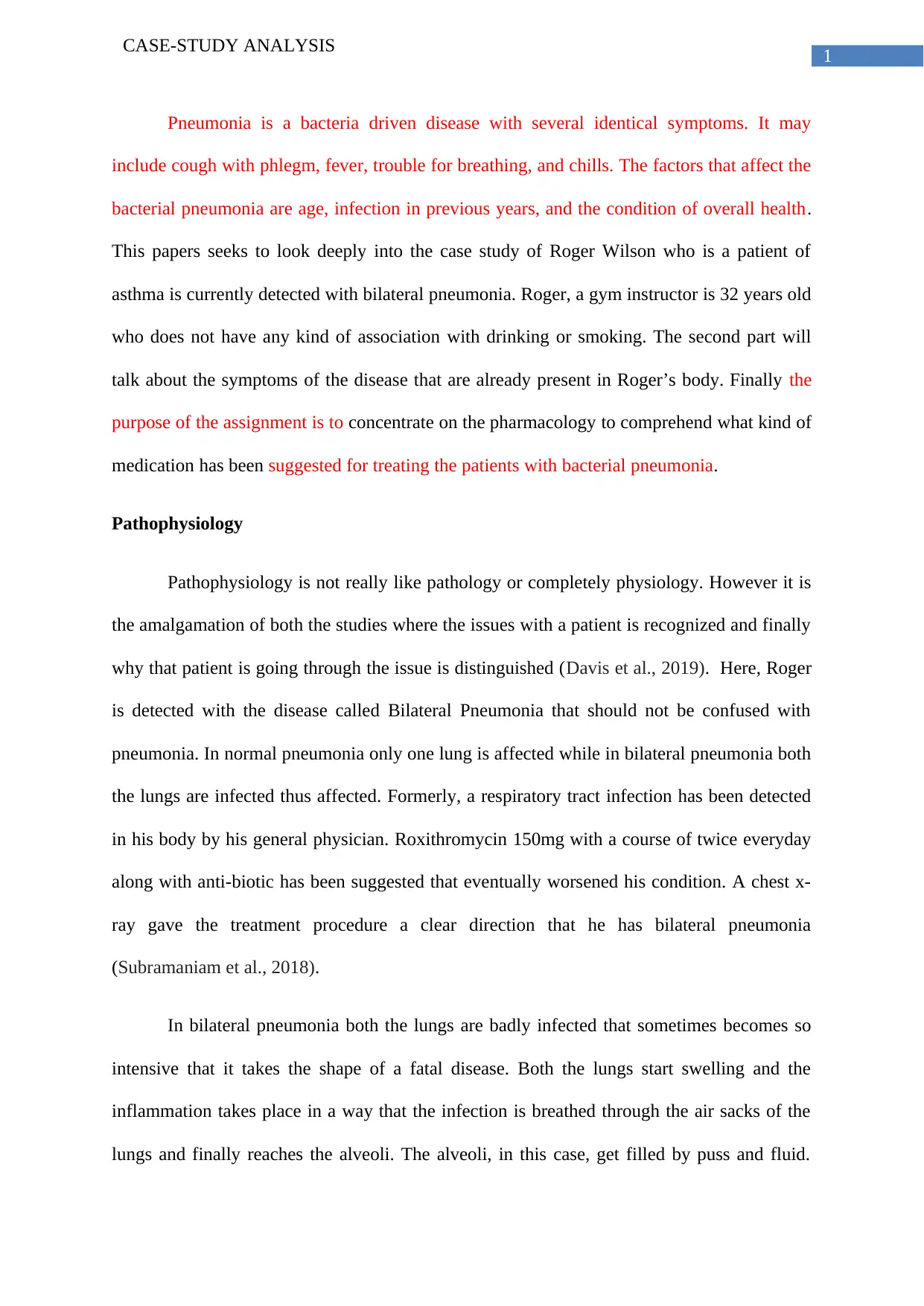
CASE-STUDY ANALYSIS 1
Pneumonia is a bacteria driven disease with several identical symptoms. It may
include cough with phlegm, fever, trouble for breathing, and chills. The factors that affect the
bacterial pneumonia are age, infection in previous years, and the condition of overall health.
This papers seeks to look deeply into the case study of Roger Wilson who is a patient of
asthma is currently detected with bilateral pneumonia. Roger, a gym instructor is 32 years old
who does not have any kind of association with drinking or smoking. The second part will
talk about the symptoms of the disease that are already present in Roger’s body. Finally the
purpose of the assignment is to concentrate on the pharmacology to comprehend what kind of
medication has been suggested for treating the patients with bacterial pneumonia.
Pathophysiology
Pathophysiology is not really like pathology or completely physiology. However it is
the amalgamation of both the studies where the issues with a patient is recognized and finally
why that patient is going through the issue is distinguished (Davis et al., 2019). Here, Roger
is detected with the disease called Bilateral Pneumonia that should not be confused with
pneumonia. In normal pneumonia only one lung is affected while in bilateral pneumonia both
the lungs are infected thus affected. Formerly, a respiratory tract infection has been detected
in his body by his general physician. Roxithromycin 150mg with a course of twice everyday
along with anti-biotic has been suggested that eventually worsened his condition. A chest x-
ray gave the treatment procedure a clear direction that he has bilateral pneumonia
(Subramaniam et al., 2018).
In bilateral pneumonia both the lungs are badly infected that sometimes becomes so
intensive that it takes the shape of a fatal disease. Both the lungs start swelling and the
inflammation takes place in a way that the infection is breathed through the air sacks of the
lungs and finally reaches the alveoli. The alveoli, in this case, get filled by puss and fluid.
Pneumonia is a bacteria driven disease with several identical symptoms. It may
include cough with phlegm, fever, trouble for breathing, and chills. The factors that affect the
bacterial pneumonia are age, infection in previous years, and the condition of overall health.
This papers seeks to look deeply into the case study of Roger Wilson who is a patient of
asthma is currently detected with bilateral pneumonia. Roger, a gym instructor is 32 years old
who does not have any kind of association with drinking or smoking. The second part will
talk about the symptoms of the disease that are already present in Roger’s body. Finally the
purpose of the assignment is to concentrate on the pharmacology to comprehend what kind of
medication has been suggested for treating the patients with bacterial pneumonia.
Pathophysiology
Pathophysiology is not really like pathology or completely physiology. However it is
the amalgamation of both the studies where the issues with a patient is recognized and finally
why that patient is going through the issue is distinguished (Davis et al., 2019). Here, Roger
is detected with the disease called Bilateral Pneumonia that should not be confused with
pneumonia. In normal pneumonia only one lung is affected while in bilateral pneumonia both
the lungs are infected thus affected. Formerly, a respiratory tract infection has been detected
in his body by his general physician. Roxithromycin 150mg with a course of twice everyday
along with anti-biotic has been suggested that eventually worsened his condition. A chest x-
ray gave the treatment procedure a clear direction that he has bilateral pneumonia
(Subramaniam et al., 2018).
In bilateral pneumonia both the lungs are badly infected that sometimes becomes so
intensive that it takes the shape of a fatal disease. Both the lungs start swelling and the
inflammation takes place in a way that the infection is breathed through the air sacks of the
lungs and finally reaches the alveoli. The alveoli, in this case, get filled by puss and fluid.
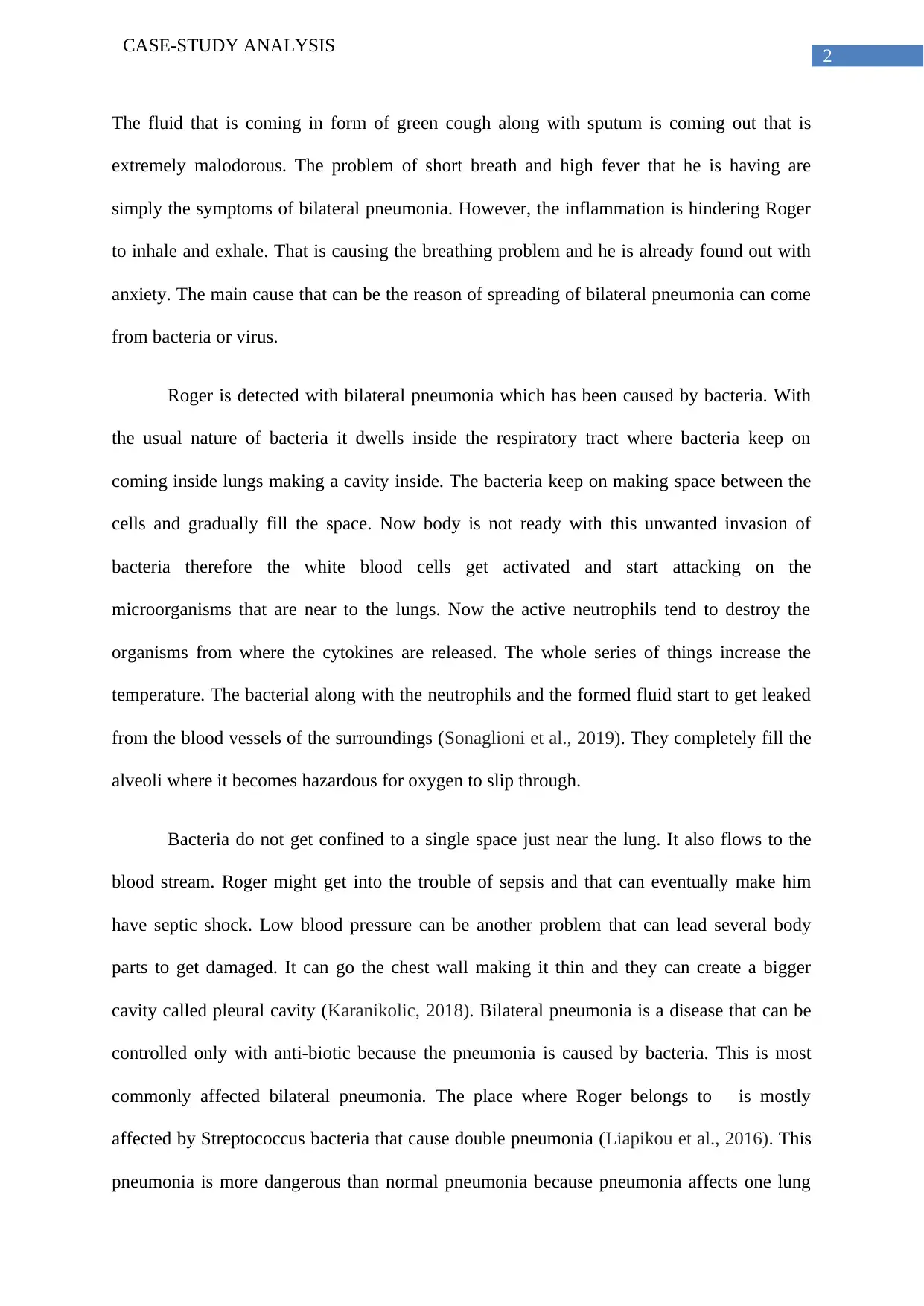
2
CASE-STUDY ANALYSIS
The fluid that is coming in form of green cough along with sputum is coming out that is
extremely malodorous. The problem of short breath and high fever that he is having are
simply the symptoms of bilateral pneumonia. However, the inflammation is hindering Roger
to inhale and exhale. That is causing the breathing problem and he is already found out with
anxiety. The main cause that can be the reason of spreading of bilateral pneumonia can come
from bacteria or virus.
Roger is detected with bilateral pneumonia which has been caused by bacteria. With
the usual nature of bacteria it dwells inside the respiratory tract where bacteria keep on
coming inside lungs making a cavity inside. The bacteria keep on making space between the
cells and gradually fill the space. Now body is not ready with this unwanted invasion of
bacteria therefore the white blood cells get activated and start attacking on the
microorganisms that are near to the lungs. Now the active neutrophils tend to destroy the
organisms from where the cytokines are released. The whole series of things increase the
temperature. The bacterial along with the neutrophils and the formed fluid start to get leaked
from the blood vessels of the surroundings (Sonaglioni et al., 2019). They completely fill the
alveoli where it becomes hazardous for oxygen to slip through.
Bacteria do not get confined to a single space just near the lung. It also flows to the
blood stream. Roger might get into the trouble of sepsis and that can eventually make him
have septic shock. Low blood pressure can be another problem that can lead several body
parts to get damaged. It can go the chest wall making it thin and they can create a bigger
cavity called pleural cavity (Karanikolic, 2018). Bilateral pneumonia is a disease that can be
controlled only with anti-biotic because the pneumonia is caused by bacteria. This is most
commonly affected bilateral pneumonia. The place where Roger belongs to is mostly
affected by Streptococcus bacteria that cause double pneumonia (Liapikou et al., 2016). This
pneumonia is more dangerous than normal pneumonia because pneumonia affects one lung
CASE-STUDY ANALYSIS
The fluid that is coming in form of green cough along with sputum is coming out that is
extremely malodorous. The problem of short breath and high fever that he is having are
simply the symptoms of bilateral pneumonia. However, the inflammation is hindering Roger
to inhale and exhale. That is causing the breathing problem and he is already found out with
anxiety. The main cause that can be the reason of spreading of bilateral pneumonia can come
from bacteria or virus.
Roger is detected with bilateral pneumonia which has been caused by bacteria. With
the usual nature of bacteria it dwells inside the respiratory tract where bacteria keep on
coming inside lungs making a cavity inside. The bacteria keep on making space between the
cells and gradually fill the space. Now body is not ready with this unwanted invasion of
bacteria therefore the white blood cells get activated and start attacking on the
microorganisms that are near to the lungs. Now the active neutrophils tend to destroy the
organisms from where the cytokines are released. The whole series of things increase the
temperature. The bacterial along with the neutrophils and the formed fluid start to get leaked
from the blood vessels of the surroundings (Sonaglioni et al., 2019). They completely fill the
alveoli where it becomes hazardous for oxygen to slip through.
Bacteria do not get confined to a single space just near the lung. It also flows to the
blood stream. Roger might get into the trouble of sepsis and that can eventually make him
have septic shock. Low blood pressure can be another problem that can lead several body
parts to get damaged. It can go the chest wall making it thin and they can create a bigger
cavity called pleural cavity (Karanikolic, 2018). Bilateral pneumonia is a disease that can be
controlled only with anti-biotic because the pneumonia is caused by bacteria. This is most
commonly affected bilateral pneumonia. The place where Roger belongs to is mostly
affected by Streptococcus bacteria that cause double pneumonia (Liapikou et al., 2016). This
pneumonia is more dangerous than normal pneumonia because pneumonia affects one lung
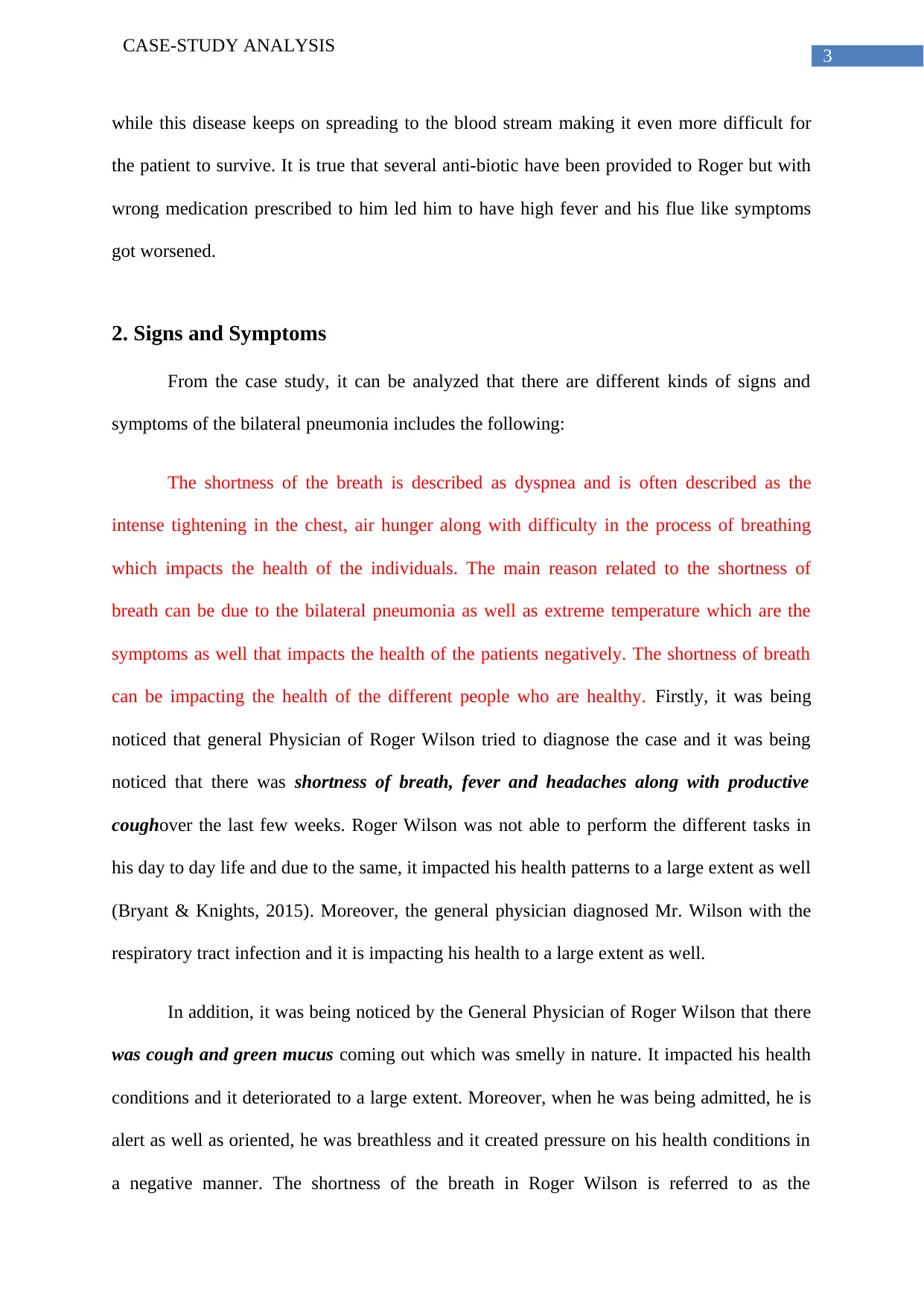
3
CASE-STUDY ANALYSIS
while this disease keeps on spreading to the blood stream making it even more difficult for
the patient to survive. It is true that several anti-biotic have been provided to Roger but with
wrong medication prescribed to him led him to have high fever and his flue like symptoms
got worsened.
2. Signs and Symptoms
From the case study, it can be analyzed that there are different kinds of signs and
symptoms of the bilateral pneumonia includes the following:
The shortness of the breath is described as dyspnea and is often described as the
intense tightening in the chest, air hunger along with difficulty in the process of breathing
which impacts the health of the individuals. The main reason related to the shortness of
breath can be due to the bilateral pneumonia as well as extreme temperature which are the
symptoms as well that impacts the health of the patients negatively. The shortness of breath
can be impacting the health of the different people who are healthy. Firstly, it was being
noticed that general Physician of Roger Wilson tried to diagnose the case and it was being
noticed that there was shortness of breath, fever and headaches along with productive
coughover the last few weeks. Roger Wilson was not able to perform the different tasks in
his day to day life and due to the same, it impacted his health patterns to a large extent as well
(Bryant & Knights, 2015). Moreover, the general physician diagnosed Mr. Wilson with the
respiratory tract infection and it is impacting his health to a large extent as well.
In addition, it was being noticed by the General Physician of Roger Wilson that there
was cough and green mucus coming out which was smelly in nature. It impacted his health
conditions and it deteriorated to a large extent. Moreover, when he was being admitted, he is
alert as well as oriented, he was breathless and it created pressure on his health conditions in
a negative manner. The shortness of the breath in Roger Wilson is referred to as the
CASE-STUDY ANALYSIS
while this disease keeps on spreading to the blood stream making it even more difficult for
the patient to survive. It is true that several anti-biotic have been provided to Roger but with
wrong medication prescribed to him led him to have high fever and his flue like symptoms
got worsened.
2. Signs and Symptoms
From the case study, it can be analyzed that there are different kinds of signs and
symptoms of the bilateral pneumonia includes the following:
The shortness of the breath is described as dyspnea and is often described as the
intense tightening in the chest, air hunger along with difficulty in the process of breathing
which impacts the health of the individuals. The main reason related to the shortness of
breath can be due to the bilateral pneumonia as well as extreme temperature which are the
symptoms as well that impacts the health of the patients negatively. The shortness of breath
can be impacting the health of the different people who are healthy. Firstly, it was being
noticed that general Physician of Roger Wilson tried to diagnose the case and it was being
noticed that there was shortness of breath, fever and headaches along with productive
coughover the last few weeks. Roger Wilson was not able to perform the different tasks in
his day to day life and due to the same, it impacted his health patterns to a large extent as well
(Bryant & Knights, 2015). Moreover, the general physician diagnosed Mr. Wilson with the
respiratory tract infection and it is impacting his health to a large extent as well.
In addition, it was being noticed by the General Physician of Roger Wilson that there
was cough and green mucus coming out which was smelly in nature. It impacted his health
conditions and it deteriorated to a large extent. Moreover, when he was being admitted, he is
alert as well as oriented, he was breathless and it created pressure on his health conditions in
a negative manner. The shortness of the breath in Roger Wilson is referred to as the
Secure Best Marks with AI Grader
Need help grading? Try our AI Grader for instant feedback on your assignments.
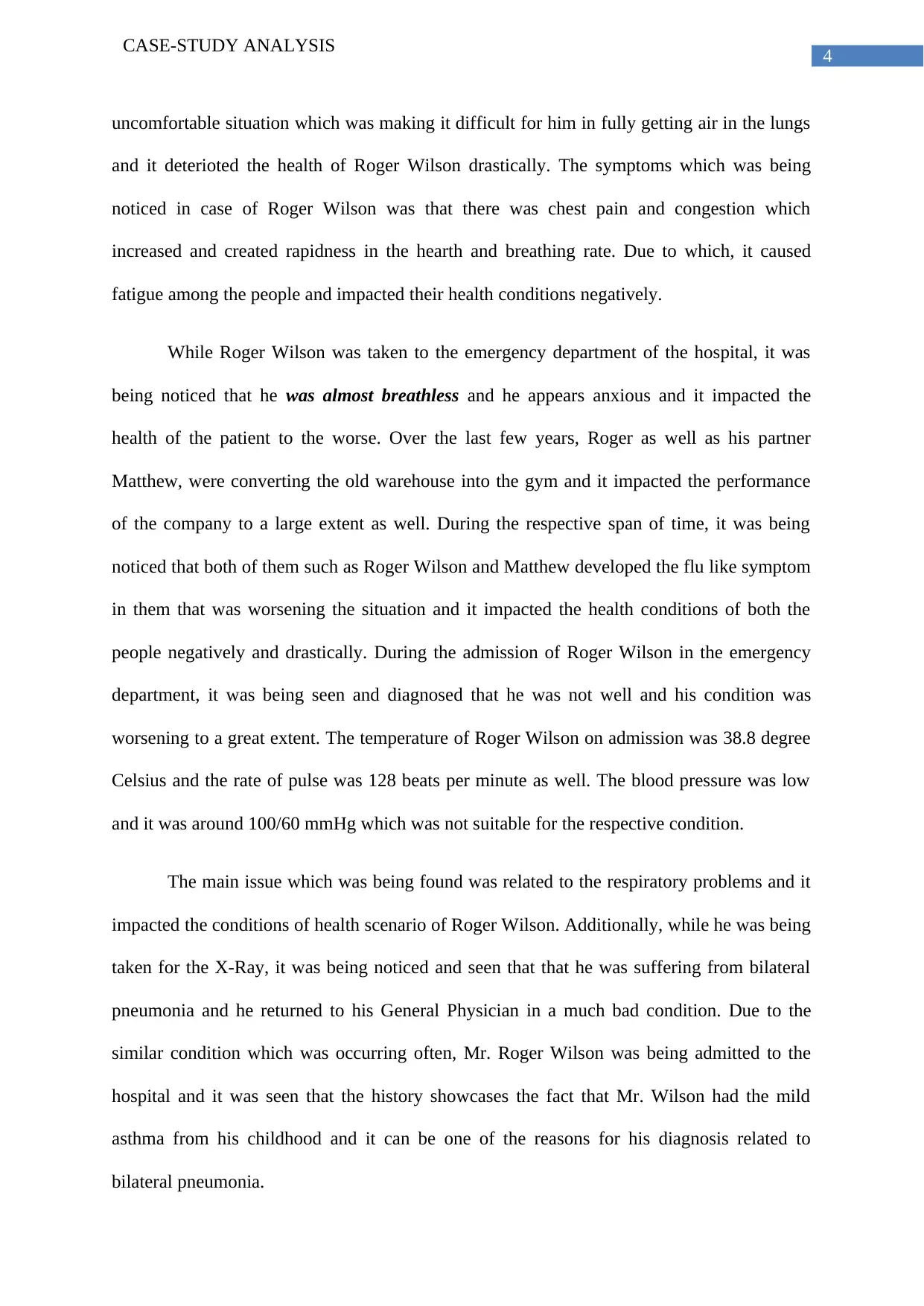
4
CASE-STUDY ANALYSIS
uncomfortable situation which was making it difficult for him in fully getting air in the lungs
and it deterioted the health of Roger Wilson drastically. The symptoms which was being
noticed in case of Roger Wilson was that there was chest pain and congestion which
increased and created rapidness in the hearth and breathing rate. Due to which, it caused
fatigue among the people and impacted their health conditions negatively.
While Roger Wilson was taken to the emergency department of the hospital, it was
being noticed that he was almost breathless and he appears anxious and it impacted the
health of the patient to the worse. Over the last few years, Roger as well as his partner
Matthew, were converting the old warehouse into the gym and it impacted the performance
of the company to a large extent as well. During the respective span of time, it was being
noticed that both of them such as Roger Wilson and Matthew developed the flu like symptom
in them that was worsening the situation and it impacted the health conditions of both the
people negatively and drastically. During the admission of Roger Wilson in the emergency
department, it was being seen and diagnosed that he was not well and his condition was
worsening to a great extent. The temperature of Roger Wilson on admission was 38.8 degree
Celsius and the rate of pulse was 128 beats per minute as well. The blood pressure was low
and it was around 100/60 mmHg which was not suitable for the respective condition.
The main issue which was being found was related to the respiratory problems and it
impacted the conditions of health scenario of Roger Wilson. Additionally, while he was being
taken for the X-Ray, it was being noticed and seen that that he was suffering from bilateral
pneumonia and he returned to his General Physician in a much bad condition. Due to the
similar condition which was occurring often, Mr. Roger Wilson was being admitted to the
hospital and it was seen that the history showcases the fact that Mr. Wilson had the mild
asthma from his childhood and it can be one of the reasons for his diagnosis related to
bilateral pneumonia.
CASE-STUDY ANALYSIS
uncomfortable situation which was making it difficult for him in fully getting air in the lungs
and it deterioted the health of Roger Wilson drastically. The symptoms which was being
noticed in case of Roger Wilson was that there was chest pain and congestion which
increased and created rapidness in the hearth and breathing rate. Due to which, it caused
fatigue among the people and impacted their health conditions negatively.
While Roger Wilson was taken to the emergency department of the hospital, it was
being noticed that he was almost breathless and he appears anxious and it impacted the
health of the patient to the worse. Over the last few years, Roger as well as his partner
Matthew, were converting the old warehouse into the gym and it impacted the performance
of the company to a large extent as well. During the respective span of time, it was being
noticed that both of them such as Roger Wilson and Matthew developed the flu like symptom
in them that was worsening the situation and it impacted the health conditions of both the
people negatively and drastically. During the admission of Roger Wilson in the emergency
department, it was being seen and diagnosed that he was not well and his condition was
worsening to a great extent. The temperature of Roger Wilson on admission was 38.8 degree
Celsius and the rate of pulse was 128 beats per minute as well. The blood pressure was low
and it was around 100/60 mmHg which was not suitable for the respective condition.
The main issue which was being found was related to the respiratory problems and it
impacted the conditions of health scenario of Roger Wilson. Additionally, while he was being
taken for the X-Ray, it was being noticed and seen that that he was suffering from bilateral
pneumonia and he returned to his General Physician in a much bad condition. Due to the
similar condition which was occurring often, Mr. Roger Wilson was being admitted to the
hospital and it was seen that the history showcases the fact that Mr. Wilson had the mild
asthma from his childhood and it can be one of the reasons for his diagnosis related to
bilateral pneumonia.
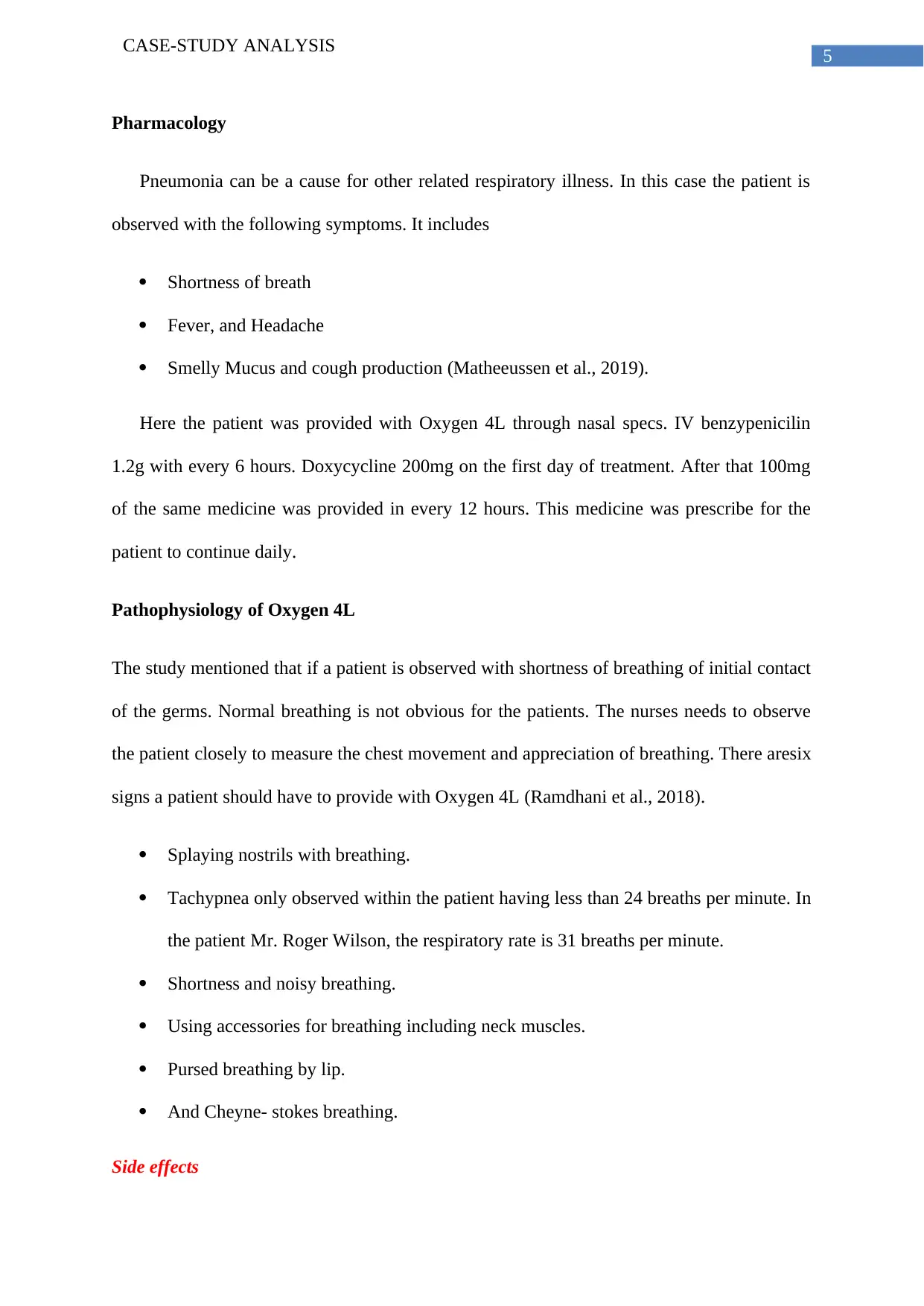
5
CASE-STUDY ANALYSIS
Pharmacology
Pneumonia can be a cause for other related respiratory illness. In this case the patient is
observed with the following symptoms. It includes
Shortness of breath
Fever, and Headache
Smelly Mucus and cough production (Matheeussen et al., 2019).
Here the patient was provided with Oxygen 4L through nasal specs. IV benzypenicilin
1.2g with every 6 hours. Doxycycline 200mg on the first day of treatment. After that 100mg
of the same medicine was provided in every 12 hours. This medicine was prescribe for the
patient to continue daily.
Pathophysiology of Oxygen 4L
The study mentioned that if a patient is observed with shortness of breathing of initial contact
of the germs. Normal breathing is not obvious for the patients. The nurses needs to observe
the patient closely to measure the chest movement and appreciation of breathing. There aresix
signs a patient should have to provide with Oxygen 4L (Ramdhani et al., 2018).
Splaying nostrils with breathing.
Tachypnea only observed within the patient having less than 24 breaths per minute. In
the patient Mr. Roger Wilson, the respiratory rate is 31 breaths per minute.
Shortness and noisy breathing.
Using accessories for breathing including neck muscles.
Pursed breathing by lip.
And Cheyne- stokes breathing.
Side effects
CASE-STUDY ANALYSIS
Pharmacology
Pneumonia can be a cause for other related respiratory illness. In this case the patient is
observed with the following symptoms. It includes
Shortness of breath
Fever, and Headache
Smelly Mucus and cough production (Matheeussen et al., 2019).
Here the patient was provided with Oxygen 4L through nasal specs. IV benzypenicilin
1.2g with every 6 hours. Doxycycline 200mg on the first day of treatment. After that 100mg
of the same medicine was provided in every 12 hours. This medicine was prescribe for the
patient to continue daily.
Pathophysiology of Oxygen 4L
The study mentioned that if a patient is observed with shortness of breathing of initial contact
of the germs. Normal breathing is not obvious for the patients. The nurses needs to observe
the patient closely to measure the chest movement and appreciation of breathing. There aresix
signs a patient should have to provide with Oxygen 4L (Ramdhani et al., 2018).
Splaying nostrils with breathing.
Tachypnea only observed within the patient having less than 24 breaths per minute. In
the patient Mr. Roger Wilson, the respiratory rate is 31 breaths per minute.
Shortness and noisy breathing.
Using accessories for breathing including neck muscles.
Pursed breathing by lip.
And Cheyne- stokes breathing.
Side effects
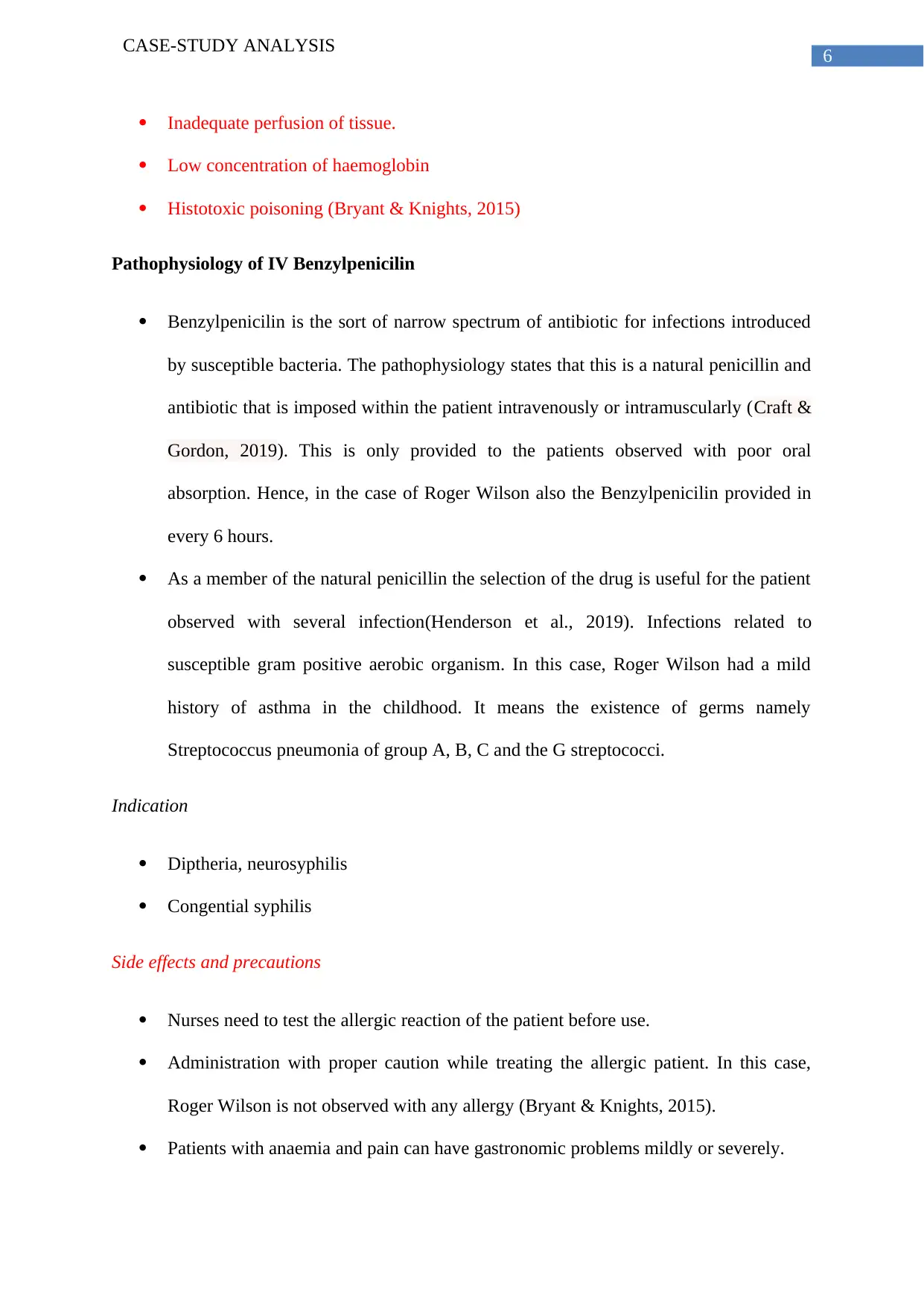
6
CASE-STUDY ANALYSIS
Inadequate perfusion of tissue.
Low concentration of haemoglobin
Histotoxic poisoning (Bryant & Knights, 2015)
Pathophysiology of IV Benzylpenicilin
Benzylpenicilin is the sort of narrow spectrum of antibiotic for infections introduced
by susceptible bacteria. The pathophysiology states that this is a natural penicillin and
antibiotic that is imposed within the patient intravenously or intramuscularly (Craft &
Gordon, 2019). This is only provided to the patients observed with poor oral
absorption. Hence, in the case of Roger Wilson also the Benzylpenicilin provided in
every 6 hours.
As a member of the natural penicillin the selection of the drug is useful for the patient
observed with several infection(Henderson et al., 2019). Infections related to
susceptible gram positive aerobic organism. In this case, Roger Wilson had a mild
history of asthma in the childhood. It means the existence of germs namely
Streptococcus pneumonia of group A, B, C and the G streptococci.
Indication
Diptheria, neurosyphilis
Congential syphilis
Side effects and precautions
Nurses need to test the allergic reaction of the patient before use.
Administration with proper caution while treating the allergic patient. In this case,
Roger Wilson is not observed with any allergy (Bryant & Knights, 2015).
Patients with anaemia and pain can have gastronomic problems mildly or severely.
CASE-STUDY ANALYSIS
Inadequate perfusion of tissue.
Low concentration of haemoglobin
Histotoxic poisoning (Bryant & Knights, 2015)
Pathophysiology of IV Benzylpenicilin
Benzylpenicilin is the sort of narrow spectrum of antibiotic for infections introduced
by susceptible bacteria. The pathophysiology states that this is a natural penicillin and
antibiotic that is imposed within the patient intravenously or intramuscularly (Craft &
Gordon, 2019). This is only provided to the patients observed with poor oral
absorption. Hence, in the case of Roger Wilson also the Benzylpenicilin provided in
every 6 hours.
As a member of the natural penicillin the selection of the drug is useful for the patient
observed with several infection(Henderson et al., 2019). Infections related to
susceptible gram positive aerobic organism. In this case, Roger Wilson had a mild
history of asthma in the childhood. It means the existence of germs namely
Streptococcus pneumonia of group A, B, C and the G streptococci.
Indication
Diptheria, neurosyphilis
Congential syphilis
Side effects and precautions
Nurses need to test the allergic reaction of the patient before use.
Administration with proper caution while treating the allergic patient. In this case,
Roger Wilson is not observed with any allergy (Bryant & Knights, 2015).
Patients with anaemia and pain can have gastronomic problems mildly or severely.
Paraphrase This Document
Need a fresh take? Get an instant paraphrase of this document with our AI Paraphraser
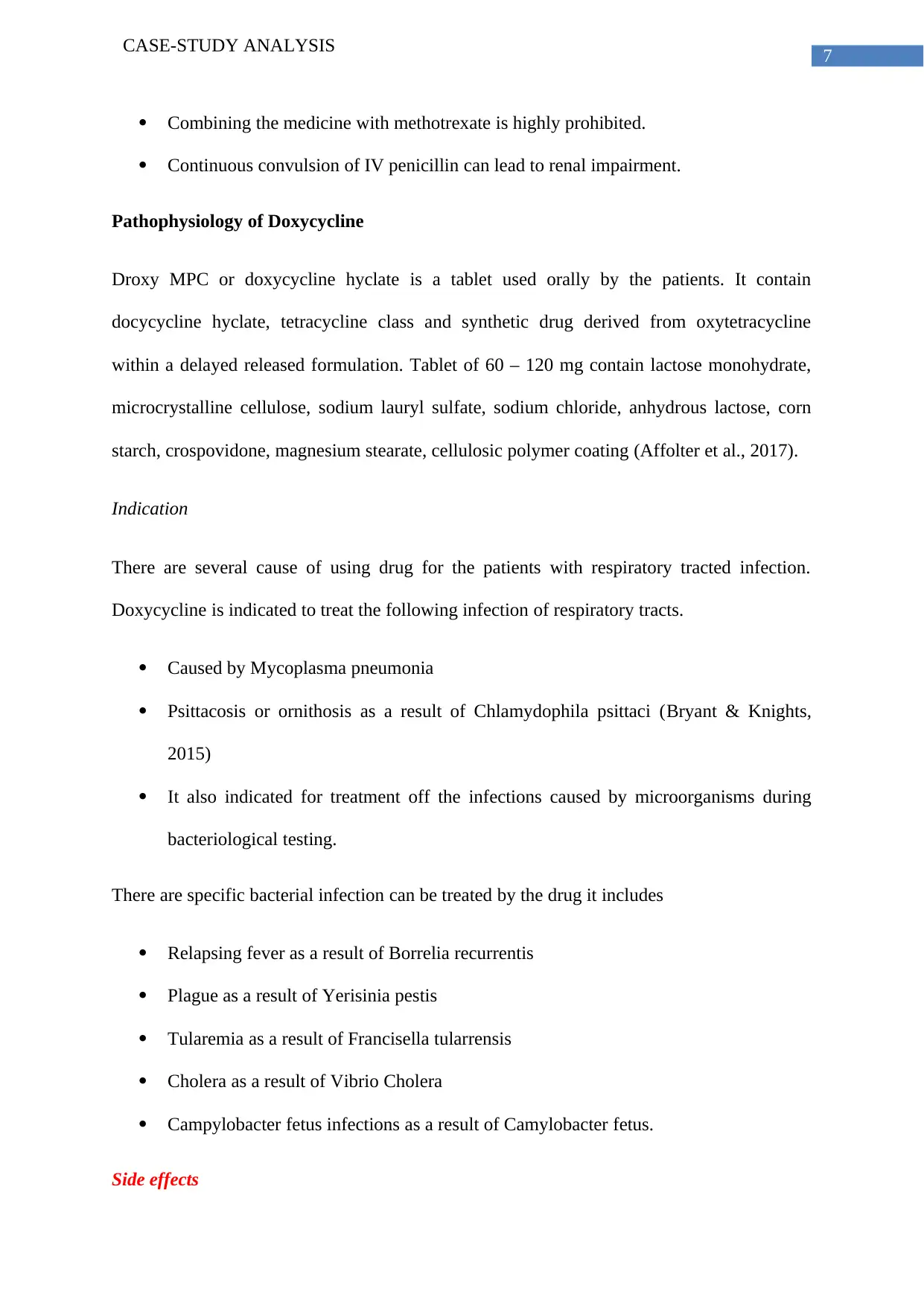
7
CASE-STUDY ANALYSIS
Combining the medicine with methotrexate is highly prohibited.
Continuous convulsion of IV penicillin can lead to renal impairment.
Pathophysiology of Doxycycline
Droxy MPC or doxycycline hyclate is a tablet used orally by the patients. It contain
docycycline hyclate, tetracycline class and synthetic drug derived from oxytetracycline
within a delayed released formulation. Tablet of 60 – 120 mg contain lactose monohydrate,
microcrystalline cellulose, sodium lauryl sulfate, sodium chloride, anhydrous lactose, corn
starch, crospovidone, magnesium stearate, cellulosic polymer coating (Affolter et al., 2017).
Indication
There are several cause of using drug for the patients with respiratory tracted infection.
Doxycycline is indicated to treat the following infection of respiratory tracts.
Caused by Mycoplasma pneumonia
Psittacosis or ornithosis as a result of Chlamydophila psittaci (Bryant & Knights,
2015)
It also indicated for treatment off the infections caused by microorganisms during
bacteriological testing.
There are specific bacterial infection can be treated by the drug it includes
Relapsing fever as a result of Borrelia recurrentis
Plague as a result of Yerisinia pestis
Tularemia as a result of Francisella tularrensis
Cholera as a result of Vibrio Cholera
Campylobacter fetus infections as a result of Camylobacter fetus.
Side effects
CASE-STUDY ANALYSIS
Combining the medicine with methotrexate is highly prohibited.
Continuous convulsion of IV penicillin can lead to renal impairment.
Pathophysiology of Doxycycline
Droxy MPC or doxycycline hyclate is a tablet used orally by the patients. It contain
docycycline hyclate, tetracycline class and synthetic drug derived from oxytetracycline
within a delayed released formulation. Tablet of 60 – 120 mg contain lactose monohydrate,
microcrystalline cellulose, sodium lauryl sulfate, sodium chloride, anhydrous lactose, corn
starch, crospovidone, magnesium stearate, cellulosic polymer coating (Affolter et al., 2017).
Indication
There are several cause of using drug for the patients with respiratory tracted infection.
Doxycycline is indicated to treat the following infection of respiratory tracts.
Caused by Mycoplasma pneumonia
Psittacosis or ornithosis as a result of Chlamydophila psittaci (Bryant & Knights,
2015)
It also indicated for treatment off the infections caused by microorganisms during
bacteriological testing.
There are specific bacterial infection can be treated by the drug it includes
Relapsing fever as a result of Borrelia recurrentis
Plague as a result of Yerisinia pestis
Tularemia as a result of Francisella tularrensis
Cholera as a result of Vibrio Cholera
Campylobacter fetus infections as a result of Camylobacter fetus.
Side effects
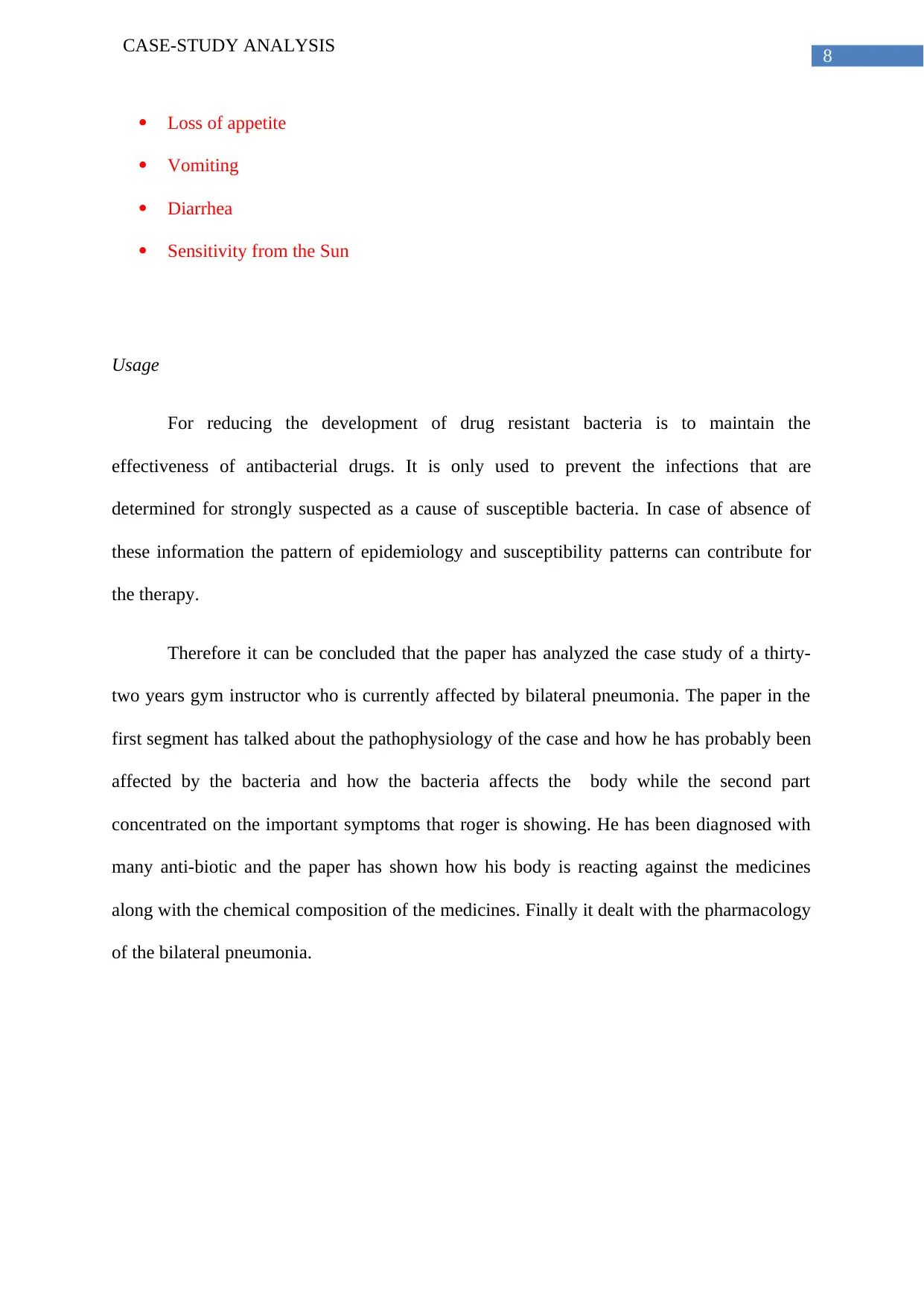
8
CASE-STUDY ANALYSIS
Loss of appetite
Vomiting
Diarrhea
Sensitivity from the Sun
Usage
For reducing the development of drug resistant bacteria is to maintain the
effectiveness of antibacterial drugs. It is only used to prevent the infections that are
determined for strongly suspected as a cause of susceptible bacteria. In case of absence of
these information the pattern of epidemiology and susceptibility patterns can contribute for
the therapy.
Therefore it can be concluded that the paper has analyzed the case study of a thirty-
two years gym instructor who is currently affected by bilateral pneumonia. The paper in the
first segment has talked about the pathophysiology of the case and how he has probably been
affected by the bacteria and how the bacteria affects the body while the second part
concentrated on the important symptoms that roger is showing. He has been diagnosed with
many anti-biotic and the paper has shown how his body is reacting against the medicines
along with the chemical composition of the medicines. Finally it dealt with the pharmacology
of the bilateral pneumonia.
CASE-STUDY ANALYSIS
Loss of appetite
Vomiting
Diarrhea
Sensitivity from the Sun
Usage
For reducing the development of drug resistant bacteria is to maintain the
effectiveness of antibacterial drugs. It is only used to prevent the infections that are
determined for strongly suspected as a cause of susceptible bacteria. In case of absence of
these information the pattern of epidemiology and susceptibility patterns can contribute for
the therapy.
Therefore it can be concluded that the paper has analyzed the case study of a thirty-
two years gym instructor who is currently affected by bilateral pneumonia. The paper in the
first segment has talked about the pathophysiology of the case and how he has probably been
affected by the bacteria and how the bacteria affects the body while the second part
concentrated on the important symptoms that roger is showing. He has been diagnosed with
many anti-biotic and the paper has shown how his body is reacting against the medicines
along with the chemical composition of the medicines. Finally it dealt with the pharmacology
of the bilateral pneumonia.
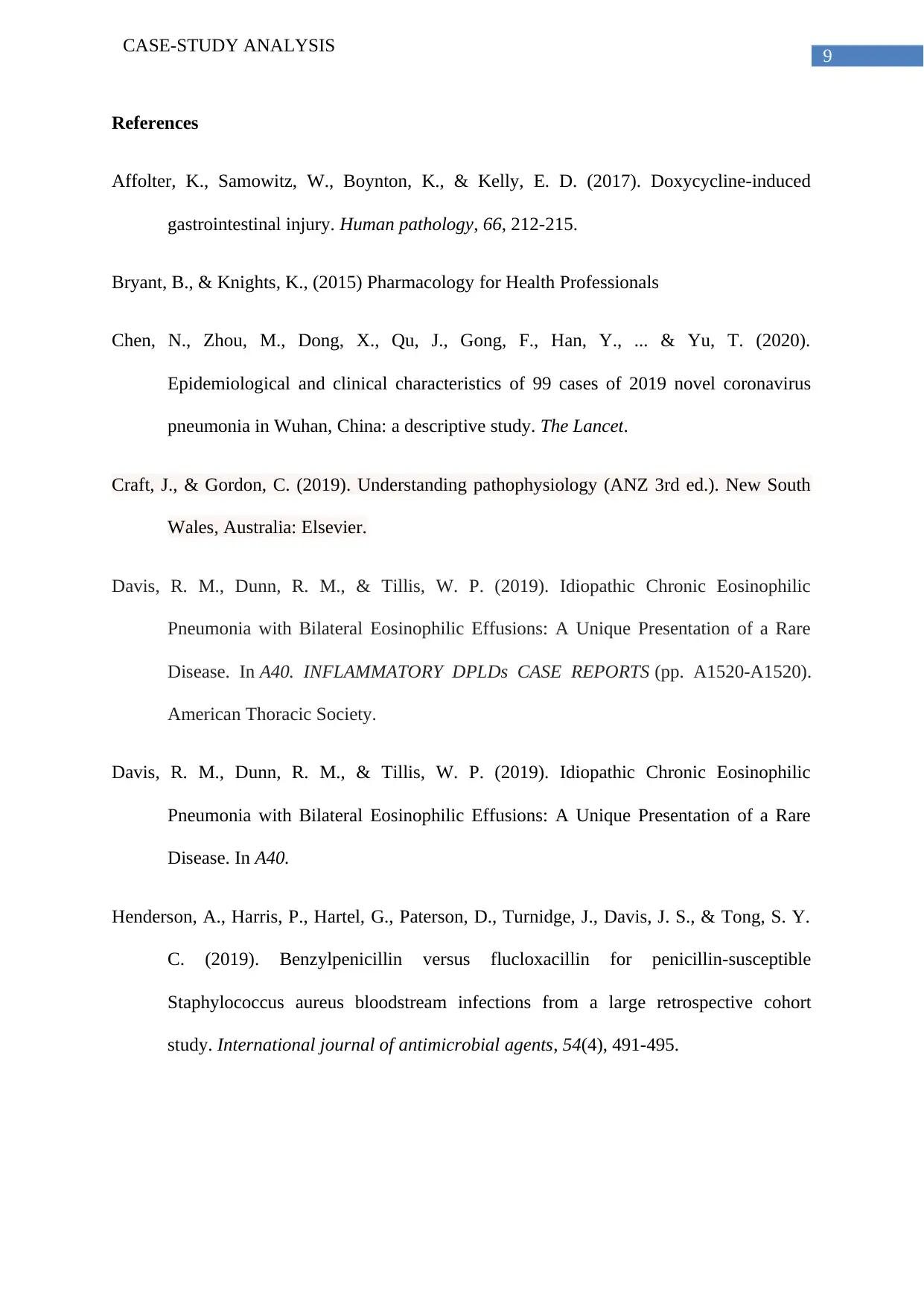
9
CASE-STUDY ANALYSIS
References
Affolter, K., Samowitz, W., Boynton, K., & Kelly, E. D. (2017). Doxycycline-induced
gastrointestinal injury. Human pathology, 66, 212-215.
Bryant, B., & Knights, K., (2015) Pharmacology for Health Professionals
Chen, N., Zhou, M., Dong, X., Qu, J., Gong, F., Han, Y., ... & Yu, T. (2020).
Epidemiological and clinical characteristics of 99 cases of 2019 novel coronavirus
pneumonia in Wuhan, China: a descriptive study. The Lancet.
Craft, J., & Gordon, C. (2019). Understanding pathophysiology (ANZ 3rd ed.). New South
Wales, Australia: Elsevier.
Davis, R. M., Dunn, R. M., & Tillis, W. P. (2019). Idiopathic Chronic Eosinophilic
Pneumonia with Bilateral Eosinophilic Effusions: A Unique Presentation of a Rare
Disease. In A40. INFLAMMATORY DPLDs CASE REPORTS (pp. A1520-A1520).
American Thoracic Society.
Davis, R. M., Dunn, R. M., & Tillis, W. P. (2019). Idiopathic Chronic Eosinophilic
Pneumonia with Bilateral Eosinophilic Effusions: A Unique Presentation of a Rare
Disease. In A40.
Henderson, A., Harris, P., Hartel, G., Paterson, D., Turnidge, J., Davis, J. S., & Tong, S. Y.
C. (2019). Benzylpenicillin versus flucloxacillin for penicillin-susceptible
Staphylococcus aureus bloodstream infections from a large retrospective cohort
study. International journal of antimicrobial agents, 54(4), 491-495.
CASE-STUDY ANALYSIS
References
Affolter, K., Samowitz, W., Boynton, K., & Kelly, E. D. (2017). Doxycycline-induced
gastrointestinal injury. Human pathology, 66, 212-215.
Bryant, B., & Knights, K., (2015) Pharmacology for Health Professionals
Chen, N., Zhou, M., Dong, X., Qu, J., Gong, F., Han, Y., ... & Yu, T. (2020).
Epidemiological and clinical characteristics of 99 cases of 2019 novel coronavirus
pneumonia in Wuhan, China: a descriptive study. The Lancet.
Craft, J., & Gordon, C. (2019). Understanding pathophysiology (ANZ 3rd ed.). New South
Wales, Australia: Elsevier.
Davis, R. M., Dunn, R. M., & Tillis, W. P. (2019). Idiopathic Chronic Eosinophilic
Pneumonia with Bilateral Eosinophilic Effusions: A Unique Presentation of a Rare
Disease. In A40. INFLAMMATORY DPLDs CASE REPORTS (pp. A1520-A1520).
American Thoracic Society.
Davis, R. M., Dunn, R. M., & Tillis, W. P. (2019). Idiopathic Chronic Eosinophilic
Pneumonia with Bilateral Eosinophilic Effusions: A Unique Presentation of a Rare
Disease. In A40.
Henderson, A., Harris, P., Hartel, G., Paterson, D., Turnidge, J., Davis, J. S., & Tong, S. Y.
C. (2019). Benzylpenicillin versus flucloxacillin for penicillin-susceptible
Staphylococcus aureus bloodstream infections from a large retrospective cohort
study. International journal of antimicrobial agents, 54(4), 491-495.
Secure Best Marks with AI Grader
Need help grading? Try our AI Grader for instant feedback on your assignments.
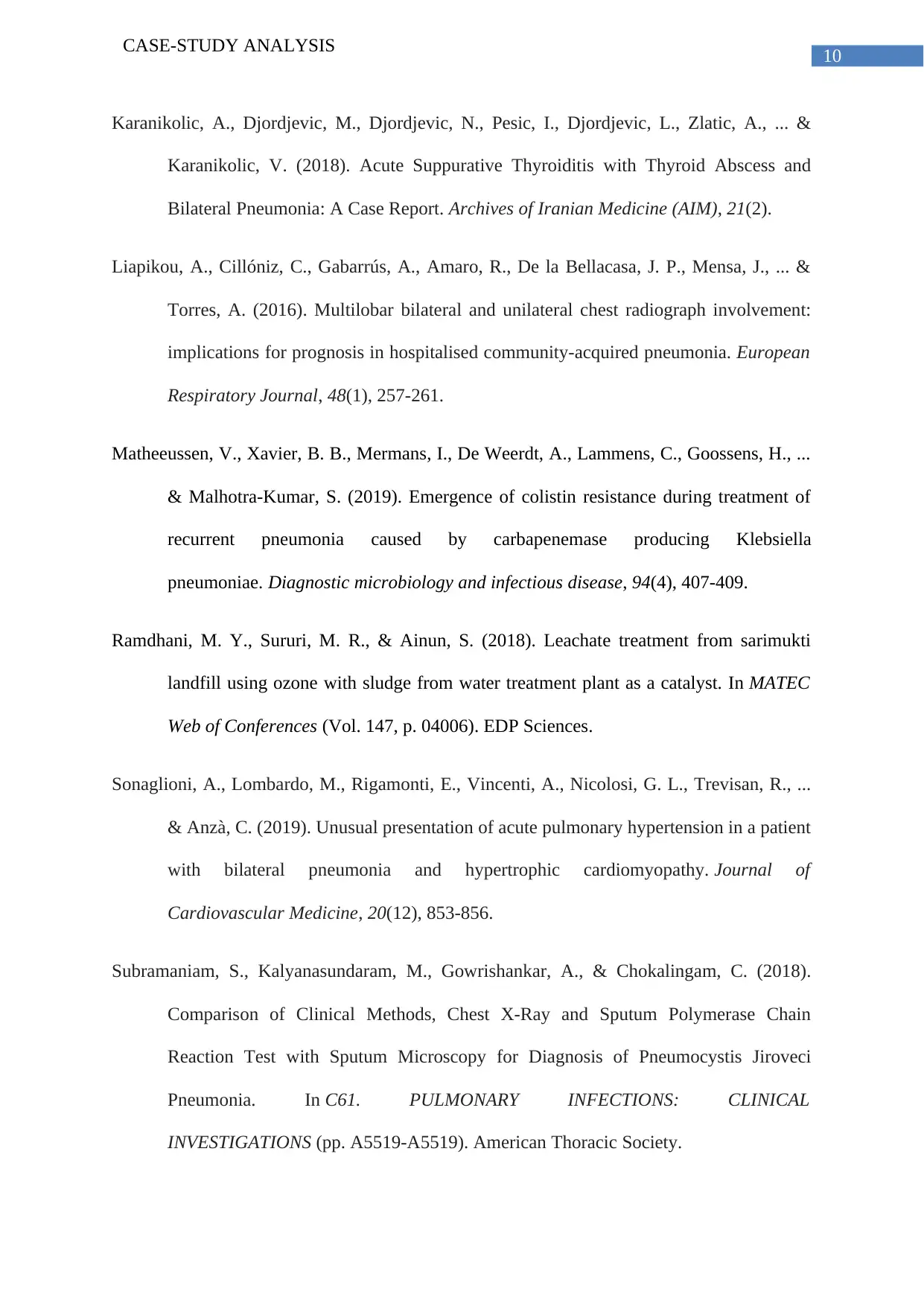
10
CASE-STUDY ANALYSIS
Karanikolic, A., Djordjevic, M., Djordjevic, N., Pesic, I., Djordjevic, L., Zlatic, A., ... &
Karanikolic, V. (2018). Acute Suppurative Thyroiditis with Thyroid Abscess and
Bilateral Pneumonia: A Case Report. Archives of Iranian Medicine (AIM), 21(2).
Liapikou, A., Cillóniz, C., Gabarrús, A., Amaro, R., De la Bellacasa, J. P., Mensa, J., ... &
Torres, A. (2016). Multilobar bilateral and unilateral chest radiograph involvement:
implications for prognosis in hospitalised community-acquired pneumonia. European
Respiratory Journal, 48(1), 257-261.
Matheeussen, V., Xavier, B. B., Mermans, I., De Weerdt, A., Lammens, C., Goossens, H., ...
& Malhotra-Kumar, S. (2019). Emergence of colistin resistance during treatment of
recurrent pneumonia caused by carbapenemase producing Klebsiella
pneumoniae. Diagnostic microbiology and infectious disease, 94(4), 407-409.
Ramdhani, M. Y., Sururi, M. R., & Ainun, S. (2018). Leachate treatment from sarimukti
landfill using ozone with sludge from water treatment plant as a catalyst. In MATEC
Web of Conferences (Vol. 147, p. 04006). EDP Sciences.
Sonaglioni, A., Lombardo, M., Rigamonti, E., Vincenti, A., Nicolosi, G. L., Trevisan, R., ...
& Anzà, C. (2019). Unusual presentation of acute pulmonary hypertension in a patient
with bilateral pneumonia and hypertrophic cardiomyopathy. Journal of
Cardiovascular Medicine, 20(12), 853-856.
Subramaniam, S., Kalyanasundaram, M., Gowrishankar, A., & Chokalingam, C. (2018).
Comparison of Clinical Methods, Chest X-Ray and Sputum Polymerase Chain
Reaction Test with Sputum Microscopy for Diagnosis of Pneumocystis Jiroveci
Pneumonia. In C61. PULMONARY INFECTIONS: CLINICAL
INVESTIGATIONS (pp. A5519-A5519). American Thoracic Society.
CASE-STUDY ANALYSIS
Karanikolic, A., Djordjevic, M., Djordjevic, N., Pesic, I., Djordjevic, L., Zlatic, A., ... &
Karanikolic, V. (2018). Acute Suppurative Thyroiditis with Thyroid Abscess and
Bilateral Pneumonia: A Case Report. Archives of Iranian Medicine (AIM), 21(2).
Liapikou, A., Cillóniz, C., Gabarrús, A., Amaro, R., De la Bellacasa, J. P., Mensa, J., ... &
Torres, A. (2016). Multilobar bilateral and unilateral chest radiograph involvement:
implications for prognosis in hospitalised community-acquired pneumonia. European
Respiratory Journal, 48(1), 257-261.
Matheeussen, V., Xavier, B. B., Mermans, I., De Weerdt, A., Lammens, C., Goossens, H., ...
& Malhotra-Kumar, S. (2019). Emergence of colistin resistance during treatment of
recurrent pneumonia caused by carbapenemase producing Klebsiella
pneumoniae. Diagnostic microbiology and infectious disease, 94(4), 407-409.
Ramdhani, M. Y., Sururi, M. R., & Ainun, S. (2018). Leachate treatment from sarimukti
landfill using ozone with sludge from water treatment plant as a catalyst. In MATEC
Web of Conferences (Vol. 147, p. 04006). EDP Sciences.
Sonaglioni, A., Lombardo, M., Rigamonti, E., Vincenti, A., Nicolosi, G. L., Trevisan, R., ...
& Anzà, C. (2019). Unusual presentation of acute pulmonary hypertension in a patient
with bilateral pneumonia and hypertrophic cardiomyopathy. Journal of
Cardiovascular Medicine, 20(12), 853-856.
Subramaniam, S., Kalyanasundaram, M., Gowrishankar, A., & Chokalingam, C. (2018).
Comparison of Clinical Methods, Chest X-Ray and Sputum Polymerase Chain
Reaction Test with Sputum Microscopy for Diagnosis of Pneumocystis Jiroveci
Pneumonia. In C61. PULMONARY INFECTIONS: CLINICAL
INVESTIGATIONS (pp. A5519-A5519). American Thoracic Society.
1 out of 11
Related Documents
Your All-in-One AI-Powered Toolkit for Academic Success.
+13062052269
info@desklib.com
Available 24*7 on WhatsApp / Email
![[object Object]](/_next/static/media/star-bottom.7253800d.svg)
Unlock your academic potential
© 2024 | Zucol Services PVT LTD | All rights reserved.





